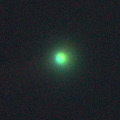
|
Appearing in the evening sky in the Southern Hemisphere. It was about 8 mag in early August in the SOHO images. It will keep observable while fading rapidly after this in the Southern Hemisphere. It is not observable in the Northern Hemisphere.
Date(TT) R.A. (2000) Decl. Delta r Elong. m1 Best Time(A, h)
Aug. 14 10 33.23 5 53.3 1.224 0.392 17 7.9 18:53 ( 96, 0)
Aug. 21 11 27.12 -1 58.3 1.150 0.504 25 8.5 18:57 ( 93, 9)
|

|
Appearing in the morning sky in the Southern Hemisphere. It approached to the sun down to 0.4 A.U. in July, and was expected to reach up to 2-3 mag. But actually, it brightened only up to 5 mag at best. It will keep observable while fading after this in the Southern Hemisphere. In the Northern Hemisphere, it will never be observable again.
Date(TT) R.A. (2000) Decl. Delta r Elong. m1 Best Time(A, h)
Aug. 14 9 24.52 -13 59.5 1.850 1.076 28 8.2 5:16 (287, 0)
Aug. 21 9 36.78 -19 24.6 1.933 1.204 32 8.9 5:09 (290, 5)
|

|
Brightened rapidly. Now it is so bright as 8.4 mag (Aug. 7, Marco Goiato). It keeps observable bright as 9-10 mag for a long time until autumn. A thin straight dust trail is visible.
Date(TT) R.A. (2000) Decl. Delta r Elong. m1 Best Time(A, h)
Aug. 14 1 23.73 -11 42.6 0.656 1.484 124 9.4 3:55 (180, 67)
Aug. 21 1 31.58 -13 8.3 0.652 1.506 128 9.5 3:35 (180, 68)
|
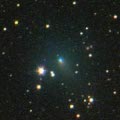
|
Brightening rapidly. Now it is 12.6 mag (Aug. 12, Jakub Cerny). A bit fainter than expected, but it is already visible visually. This apparition is best condition. It will approach to the earth down to 0.12 A.U. in October, and brighten up to 5 mag. It will be visible with naked eyes. In the Northern Hemisphere, it keeps observable all through this apparition until 2011 June when it fades down to 17 mag.
Date(TT) R.A. (2000) Decl. Delta r Elong. m1 Best Time(A, h)
Aug. 14 22 36.15 29 18.8 0.560 1.457 133 11.7 1:08 (180, 26)
Aug. 21 22 40.83 32 30.9 0.491 1.399 134 11.1 0:45 (180, 23)
|
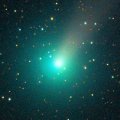
|
It brightened up to 7.9 mag in April and May (May 5, Juan Jose Gonzalez). Now it is fading. But it is still bright as 10.3 mag (Aug. 12, Jakub Cerny). It keeps observable for a long time until when it fades out in the Northern Hemisphere. It will be visible visually until autumn.
Date(TT) R.A. (2000) Decl. Delta r Elong. m1 Best Time(A, h)
Aug. 14 8 8.78 53 47.5 2.674 2.048 42 11.8 5:16 (219,-23)
Aug. 21 8 11.76 52 57.0 2.687 2.114 46 12.0 5:09 (219,-20)
|

|
It brightened up to 15.5 mag in January (Jan. 31, C. Rinner, F. Kugel). It is not observable now. The condition of this apparition is bad. It will reach up to 11-12 mag from spring to autumn, but it is not observable.
Date(TT) R.A. (2000) Decl. Delta r Elong. m1 Best Time(A, h)
Aug. 14 8 21.06 12 37.7 2.375 1.443 17 12.1 5:16 (256, -2)
Aug. 21 8 41.87 10 39.8 2.389 1.471 19 12.2 5:09 (258, -1)
|

|
It reached up to 7.7 mag in last summer (2009 Aug. 13, Chris Wyatt). It is fading now. It has already faded down to 12.6 mag (Aug. 7, Marco Goiato). In the Southern Hemisphere, it keeps observable for a long time after this. In the Northern Hemisphere, it is only observable in the extremely low sky. It will be getting lower gradually, then it will never be observable again.
Date(TT) R.A. (2000) Decl. Delta r Elong. m1 Best Time(A, h)
Aug. 14 17 37.62 -47 53.2 4.271 4.875 121 12.7 20:06 ( 0, 77)
Aug. 21 17 30.24 -47 48.5 4.419 4.922 114 12.8 19:32 ( 0, 77)
|

|
Now it is 11.7 mag (Aug. 6, Juan Jose Gonzalez). It will keep 12-13 mag until autumn. But it locates somewhat low in the Northern Hemisphere.
Date(TT) R.A. (2000) Decl. Delta r Elong. m1 Best Time(A, h)
Aug. 14 20 45.25 -33 17.3 1.671 2.639 158 13.0 23:13 (180, 88)
Aug. 21 20 40.66 -33 27.3 1.717 2.654 152 13.1 22:41 (180, 88)
|
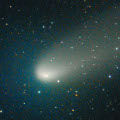
|
It reached up to 9.2 mag in March (Mar. 20, Marco Goiato). Now it is fading. It has already faded down to 12.2 mag (Aug. 6, Juan Jose Gonzalez). It keeps observable in a good condition for a long time. It keeps observable until autumn when it fades down to 16 mag.
Date(TT) R.A. (2000) Decl. Delta r Elong. m1 Best Time(A, h)
Aug. 14 15 22.02 -15 18.9 2.003 2.262 91 14.1 18:53 (141, 66)
Aug. 21 15 32.52 -16 9.1 2.122 2.303 87 14.4 18:57 (130, 64)
|

|
Now it is unobservable. It will appear in the morning sky again in October.
Date(TT) R.A. (2000) Decl. Delta r Elong. m1 Best Time(A, h)
Aug. 14 10 10.47 8 11.2 7.216 6.225 11 14.2 18:53 ( 95, -7)
Aug. 21 10 15.32 7 40.4 7.231 6.226 6 14.3 18:57 ( 91,-12)
|

|
Now it is bright as 13.4 mag and visible visually (Aug. 7, Alan Hale). It is expected to keep so bright as 6-8 mag for a long time from 2011 to 2012, and to be observable in good condition in the Northern Hemisphere. In 2010, it is observable in good condition in the Southern Hemisphere while brightening slowly. It locates low in the Northern Hemisphere, but it keeps observable until the end of 2010.
Date(TT) R.A. (2000) Decl. Delta r Elong. m1 Best Time(A, h)
Aug. 14 23 29.44 -36 47.6 4.884 5.751 145 14.5 2:02 ( 0, 88)
Aug. 21 23 22.28 -37 17.2 4.800 5.690 148 14.5 1:27 ( 0, 88)
|
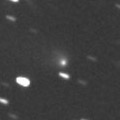
|
Now it is 15.3 mag (July 18, Hiroshi Abe). It will be observable at 13-14 mag for a long time from 2011 to 2012. In 2010, it is observable at 15-16 mag in good condition from spring to autumn.
Date(TT) R.A. (2000) Decl. Delta r Elong. m1 Best Time(A, h)
Aug. 14 21 2.13 -0 4.0 5.861 6.839 163 15.1 23:30 (180, 55)
Aug. 21 20 55.59 -0 34.6 5.846 6.807 160 15.1 22:56 (180, 56)
|
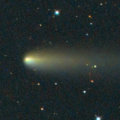
|
It brightened up to 9.5 mag in January (Jan. 13, Juan Jose Gonzalez). Now it is fading. But it is still bright as 14.5 mag (Aug. 9, Toshiyuki Takahashi). It will be also visible visually still now. It will be fainter than 18 mag at the end of 2010. In the Northern Hemisphere, it keeps observable for a long time, although it will be getting lower gradually.
Date(TT) R.A. (2000) Decl. Delta r Elong. m1 Best Time(A, h)
Aug. 14 15 5.66 48 9.2 4.169 4.021 74 15.2 18:53 (167, 5)
Aug. 21 15 12.52 46 42.1 4.256 4.078 73 15.4 18:57 (163, 5)
|

|
Now it is very bright as 14.2 mag (July 8, Toni Scarmato). It keeps observable at 14-15 mag for a long time in 2010.
Date(TT) R.A. (2000) Decl. Delta r Elong. m1 Best Time(A, h)
Aug. 14 17 24.93 40 59.7 4.236 4.527 100 15.2 19:54 (180, 14)
Aug. 21 17 25.43 40 24.9 4.274 4.522 97 15.2 19:27 (180, 15)
|
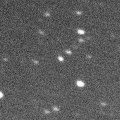
|
Now it is 15.0 mag (June 2, Hidetaka Sato). It keeps bright as 14-15 mag for a long time after this until 2013. It is observable in good condition in the Southern Hemisphere. However, it is not observable in the Northern Hemisphere.
Date(TT) R.A. (2000) Decl. Delta r Elong. m1 Best Time(A, h)
Aug. 14 14 20.92 -47 33.7 6.509 6.569 88 15.2 18:53 ( 52, 64)
Aug. 21 14 21.62 -47 35.7 6.581 6.541 83 15.2 18:57 ( 54, 59)
|
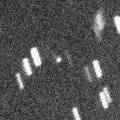
|
Not observed since May, but appearing in the morning sky. It will be observable at 14 mag in good condition in winter.
Date(TT) R.A. (2000) Decl. Delta r Elong. m1 Best Time(A, h)
Aug. 14 7 29.11 31 53.8 4.225 3.423 33 16.3 5:16 (234, -4)
Aug. 21 7 33.57 30 43.6 4.123 3.389 38 16.2 5:09 (232, -1)
|
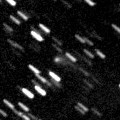
|
Now it is 16.5 mag (July 11, C. Rinner, F. Kugel). It keeps observable while fading gradually, and it will be fainter than 18 mag in November.
Date(TT) R.A. (2000) Decl. Delta r Elong. m1 Best Time(A, h)
Aug. 14 5 54.76 60 21.7 2.814 2.475 60 16.7 5:16 (202,-13)
Aug. 21 6 17.07 61 41.0 2.810 2.523 63 16.8 5:09 (201,-14)
|

|
Recovered as bright as expected. Now it is 16.5 mag (Aug. 11, Hidetaka Sato). It is observable at 15.5 mag in good condition from autumn to winter.
Date(TT) R.A. (2000) Decl. Delta r Elong. m1 Best Time(A, h)
Aug. 14 5 0.18 12 58.0 2.364 2.162 66 16.9 5:16 (220, 32)
Aug. 21 5 12.82 13 51.5 2.285 2.152 69 16.8 5:09 (217, 33)
|
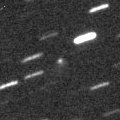
|
Now it is 16.7 mag (June 13, Hidetaka Sato). It will be observable at 17 mag in good condition in summer.
Date(TT) R.A. (2000) Decl. Delta r Elong. m1 Best Time(A, h)
Aug. 14 19 16.43 -0 1.3 2.587 3.451 143 16.9 21:44 (180, 55)
Aug. 21 19 2.85 0 24.2 2.681 3.465 134 17.0 21:03 (180, 55)
|
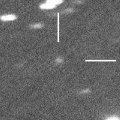
|
Now it is 17.4 mag (July 11, C. Rinner, F. Kugel). It keeps 17 mag for a long time from 2009 to 2012. It is observable in good condition in the Northern Hemisphere.
Date(TT) R.A. (2000) Decl. Delta r Elong. m1 Best Time(A, h)
Aug. 14 2 24.96 21 19.6 7.980 8.218 100 17.2 4:57 (180, 34)
Aug. 21 2 22.17 21 20.3 7.850 8.209 107 17.1 4:26 (180, 34)
|
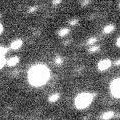
|
It was observed at 17 mag in summer and autumn in 2009. It will be observable again at 17 mag in good condition in summer and autumn also in 2010.
Date(TT) R.A. (2000) Decl. Delta r Elong. m1 Best Time(A, h)
Aug. 14 3 5.09 22 46.9 2.366 2.586 90 17.1 5:16 (185, 32)
Aug. 21 3 11.40 22 59.9 2.296 2.604 96 17.1 5:09 (182, 32)
|

|
Now it is 17.2 mag (July 21, Ken-ichi Kadota). It keeps observable at 17-18 mag for a long time until 2011 summer.
Date(TT) R.A. (2000) Decl. Delta r Elong. m1 Best Time(A, h)
Aug. 14 18 45.24 12 53.4 3.349 4.077 130 17.3 21:13 (180, 42)
Aug. 21 18 34.50 12 43.0 3.416 4.061 123 17.3 20:35 (180, 42)
|
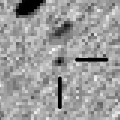
|
Now it is 19.3 mag (July 21, W. Hasubick). It will be observable at 17 mag in good condition from autum to winter. But actually, it is much fainter than expected.
Date(TT) R.A. (2000) Decl. Delta r Elong. m1 Best Time(A, h)
Aug. 14 2 33.77 34 27.8 2.134 2.420 93 17.5 5:05 (180, 21)
Aug. 21 2 39.61 36 37.1 2.061 2.421 98 17.4 4:44 (180, 18)
|
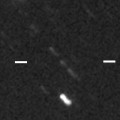
|
Now it is 18.1 mag (Aug. 3, J. Gonzalez). It is observable at 17.5 mag in good condition from summer to autumn.
Date(TT) R.A. (2000) Decl. Delta r Elong. m1 Best Time(A, h)
Aug. 14 0 44.45 32 5.2 1.177 1.846 114 18.0 3:16 (180, 23)
Aug. 21 0 50.85 33 23.3 1.124 1.839 118 17.9 2:55 (180, 22)
|
|
![]()
 C/2006 S3 ( LONEOS )
C/2006 S3 ( LONEOS ) C/2007 Q3 ( Siding Spring )
C/2007 Q3 ( Siding Spring ) C/2008 FK75 ( Lemmon-Siding Spring )
C/2008 FK75 ( Lemmon-Siding Spring ) C/2009 F4 ( McNaught )
C/2009 F4 ( McNaught ) C/2010 B1 ( Cardinal )
C/2010 B1 ( Cardinal ) 126P/IRAS
126P/IRAS 240P/2010 P1 ( NEAT )
240P/2010 P1 ( NEAT ) C/2010 J2 ( McNaught )
C/2010 J2 ( McNaught ) C/2008 S3 ( Boattini )
C/2008 S3 ( Boattini ) 219P/2009 H1 ( LINEAR )
219P/2009 H1 ( LINEAR ) C/2009 UG89 ( Lemmon )
C/2009 UG89 ( Lemmon ) 223P/2009 L18 ( Skiff )
223P/2009 L18 ( Skiff ) 236P/2010 K1 ( LINEAR )
236P/2010 K1 ( LINEAR )![]()






















